Tricks in disguise: Fools and facts in nature
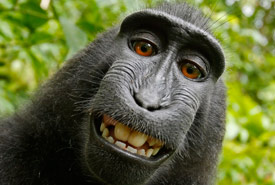
Self-portrait of a Celebes crested macaque female (Photo by Wikimedia Commons)
A friendly exchange of practical jokes and hoaxes often poses no harm, especially on such a day as April Fools’ Day. But there are some real tricksters in nature that will fool even the most attentive eyes and ears.
On April Fools’ Day, we are revealing three masterful tricks of some unassuming species and challenging you to separate the facts from the fools with our fun interactive quiz.
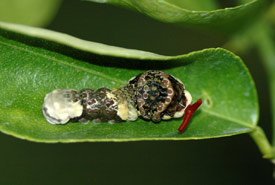
Giant swallowtail larva everting its osmeterium (Photo by Ianaré Sévi, Wikimedia Commons)
Disguised as droppings
Some caterpillars, such those of the giant swallowtail (the largest butterfly found in Canada), resemble bird droppings to evade predation. If this disguise isn’t working, the larva everts a defensive organ, called the osmeterium, which resembles a snake’s forked tongue, to startle its pursuer.
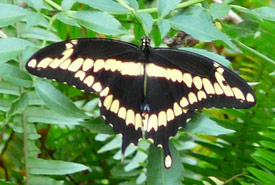
Giant swallowtail (Photo by Cary Bass, Wikimedia Commons)
This species is widespread and its range extends from Central America to the eastern U.S. In Canada, the giant swallowtail is a resident of southwestern Ontario and is commonly encountered at Point Pelee.
Stellar vocal mimicry
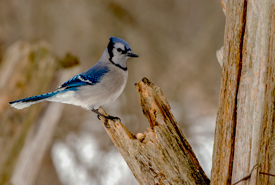
Blue jay (Photo by Lorne)
If you’ve ever heard the chilling sound of a hawk’s call in forests or your backyard, don’t jump to the conclusion there’s a hawk nearby. It may just be a blue jay’s call. This large songbird is famous for frequently mimicking the call of red-shouldered hawks to deceive other birds by suggesting that a hawk is nearby, or to inform other jays that a hawk is in the area. Captive blue jays have even been recorded to imitate human speech and a cat’s meow.
Steller’s jay is another jay in the Western Hemisphere (found mainly in parts of BC and Alberta) that has an impressive repertoire. This species can imitate some mechanical objects, as well as squirrels, cats, dogs, chickens and other birds.
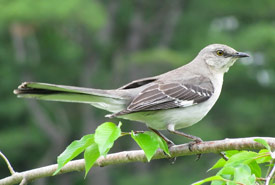
Northern mockingbird (Photo by Captain-tucker, Wikimedia Commons)
Not quite a trickster but no less clever as a copycat is the northern mockingbird, a year-round resident of Canada’s southern borders. This medium-sized songbird can perform a repertoire of songs from 10 to 15 birds. Continuously building its song library, a male mockingbird may learn 200 songs in its lifetime.
Rattle tattle
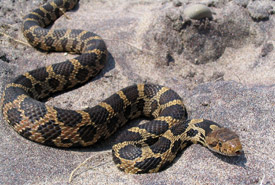
Eastern foxsnake (Photo by Ryan M. Bolton)
Rattlesnakes are not the only reptiles capable of producing a rattling noise. Eastern foxsnakes and eastern milksnakes imitate the rattle of a rattlesnake by shaking their tail on the ground when threatened. Neither of these snakes is venomous nor has a rattle! Their tails are pointed, as opposed to the blunt shape of a true rattlesnake, such as eastern massassauga.
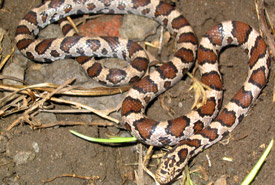
Milksnake (Photo by Ryan M. Bolton)
Unfortunately the combination of habitat loss, roadkill and persecution due to mistaking it for a venomous snake are major threats to these two species in Ontario (milksnakes also occur in Quebec).
Playing possum
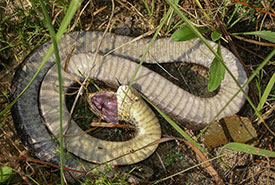
An eastern hognose snake playing dead (Photo by Charles (Chuck) Peterson, Flickr, CC BY-NC 2.0)
Some animals play dead in an attempt to evade predation. The eastern hognose snake flips onto its back, mouth agape, and fake its death if its threatening cobra-like stance doesn’t scare its pursuer.
Possums enter a involuntary, catatonic state as a fear response. They go limp, put on a grimace, stick their tongue out and discharge a stinky substance and feces. Dead animals with foul smells are often warning signals, indicative of harmful bacteria, for predators. Feigning death for various reasons has been observed in many species, from frogs to fish to spiders.
To learn more about species and conservation fast facts, take our April Fools' or Facts quiz and share what you’ve learned with family and friends.


